traction control NISSAN LEAF 2022 Owner´s Manual
[x] Cancel search | Manufacturer: NISSAN, Model Year: 2022, Model line: LEAF, Model: NISSAN LEAF 2022Pages: 618, PDF Size: 4.3 MB
Page 33 of 618
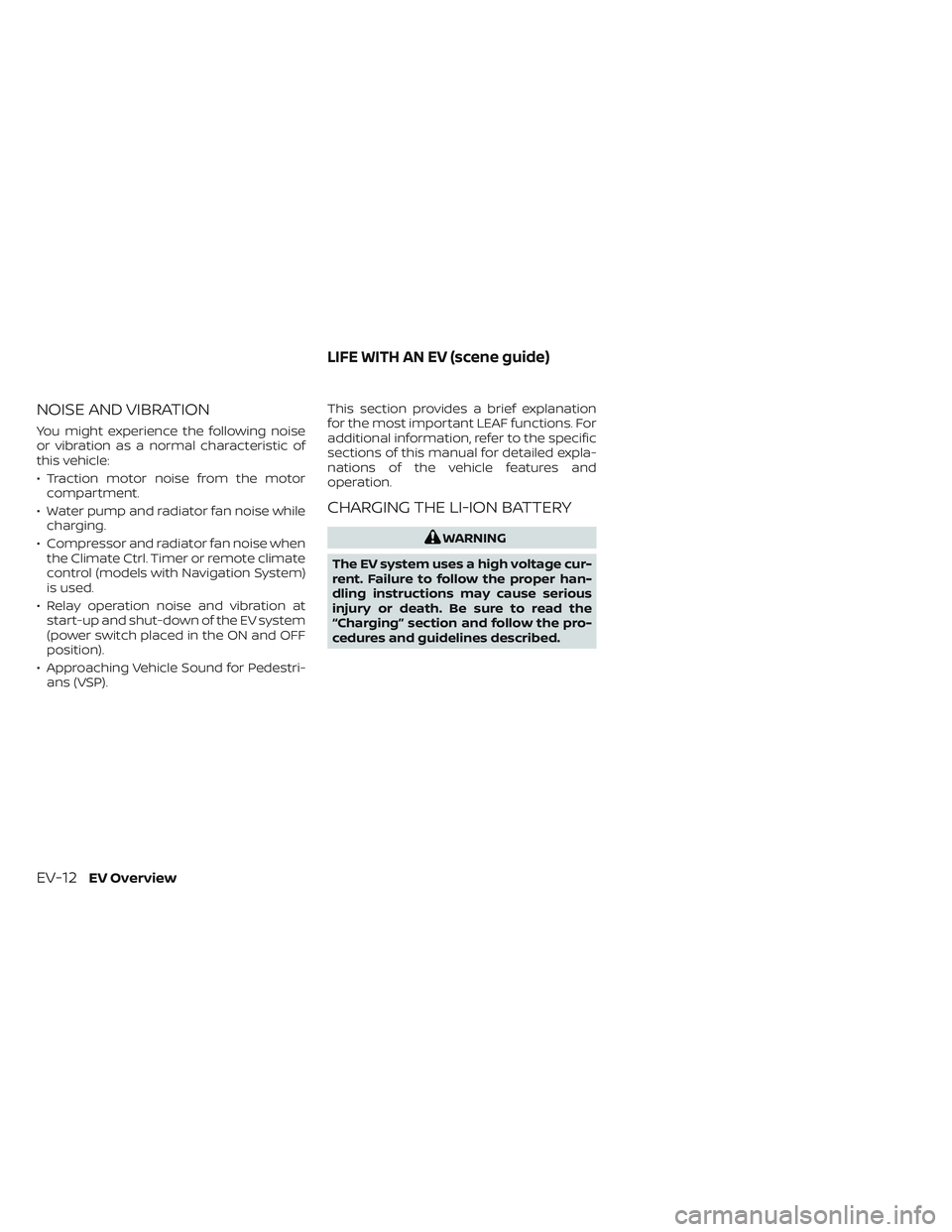
NOISE AND VIBRATION
You might experience the following noise
or vibration as a normal characteristic of
this vehicle:
• Traction motor noise from the motorcompartment.
• Water pump and radiator fan noise while charging.
• Compressor and radiator fan noise when the Climate Ctrl. Timer or remote climate
control (models with Navigation System)
is used.
• Relay operation noise and vibration at start-up and shut-down of the EV system
(power switch placed in the ON and OFF
position).
• Approaching Vehicle Sound for Pedestri- ans (VSP). This section provides a brief explanation
for the most important LEAF functions. For
additional information, refer to the specific
sections of this manual for detailed expla-
nations of the vehicle features and
operation.
CHARGING THE LI-ION BATTERY
WARNING
The EV system uses a high voltage cur-
rent. Failure to follow the proper han-
dling instructions may cause serious
injury or death. Be sure to read the
“Charging” section and follow the pro-
cedures and guidelines described.
LIFE WITH AN EV (scene guide)
EV-12EV Overview
Page 184 of 618
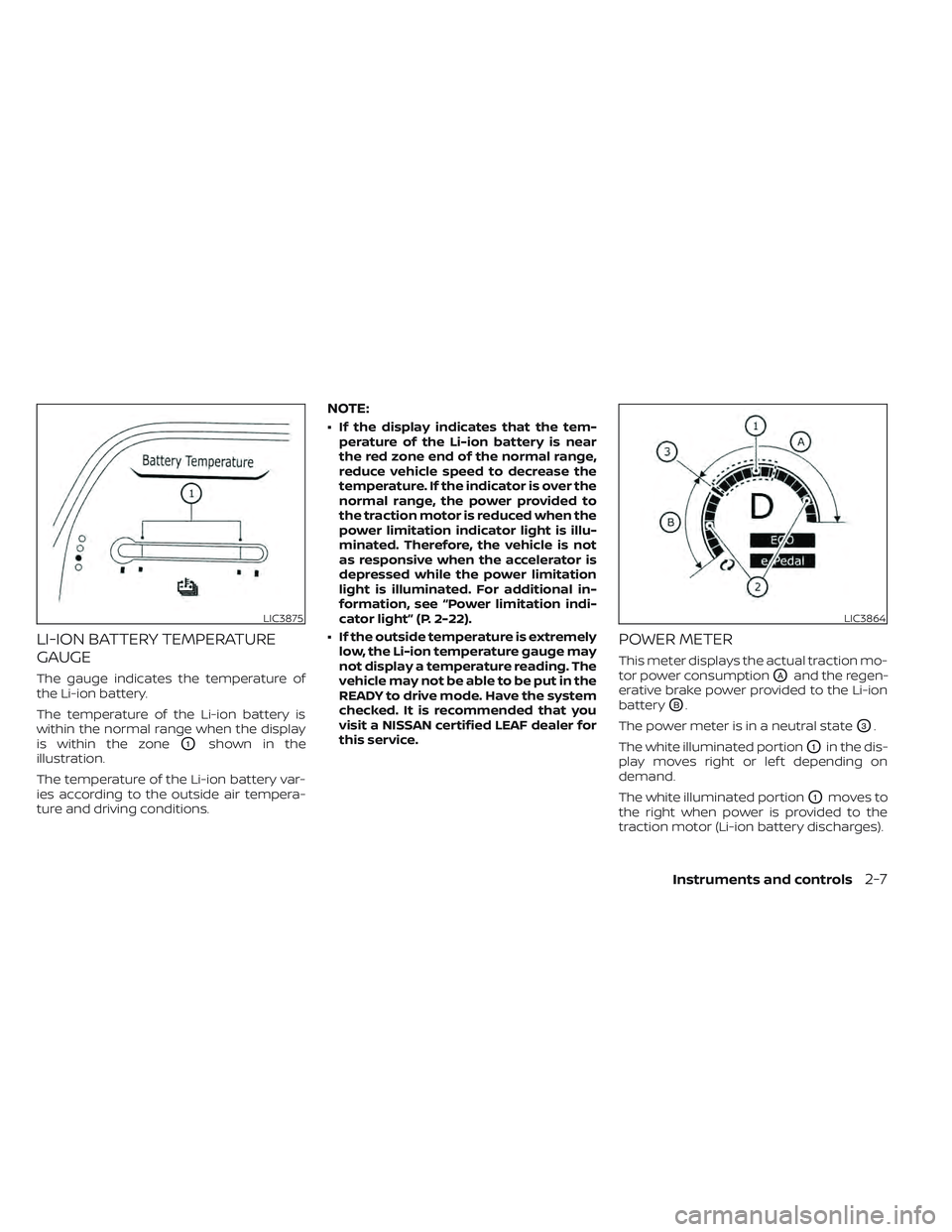
LI-ION BATTERY TEMPERATURE
GAUGE
The gauge indicates the temperature of
the Li-ion battery.
The temperature of the Li-ion battery is
within the normal range when the display
is within the zone
O1shown in the
illustration.
The temperature of the Li-ion battery var-
ies according to the outside air tempera-
ture and driving conditions.
NOTE:
• If the display indicates that the tem- perature of the Li-ion battery is near
the red zone end of the normal range,
reduce vehicle speed to decrease the
temperature. If the indicator is over the
normal range, the power provided to
the traction motor is reduced when the
power limitation indicator light is illu-
minated. Therefore, the vehicle is not
as responsive when the accelerator is
depressed while the power limitation
light is illuminated. For additional in-
formation, see “Power limitation indi-
cator light” (P. 2-22).
• If the outside temperature is extremely low, the Li-ion temperature gauge may
not display a temperature reading. The
vehicle may not be able to be put in the
READY to drive mode. Have the system
checked. It is recommended that you
visit a NISSAN certified LEAF dealer for
this service.
POWER METER
This meter displays the actual traction mo-
tor power consumption
OAand the regen-
erative brake power provided to the Li-ion
battery
OB.
The power meter is in a neutral state
O3.
The white illuminated portion
O1in the dis-
play moves right or lef t depending on
demand.
The white illuminated portion
O1moves to
the right when power is provided to the
traction motor (Li-ion battery discharges).
LIC3875LIC3864
Instruments and controls2-7
Page 185 of 618
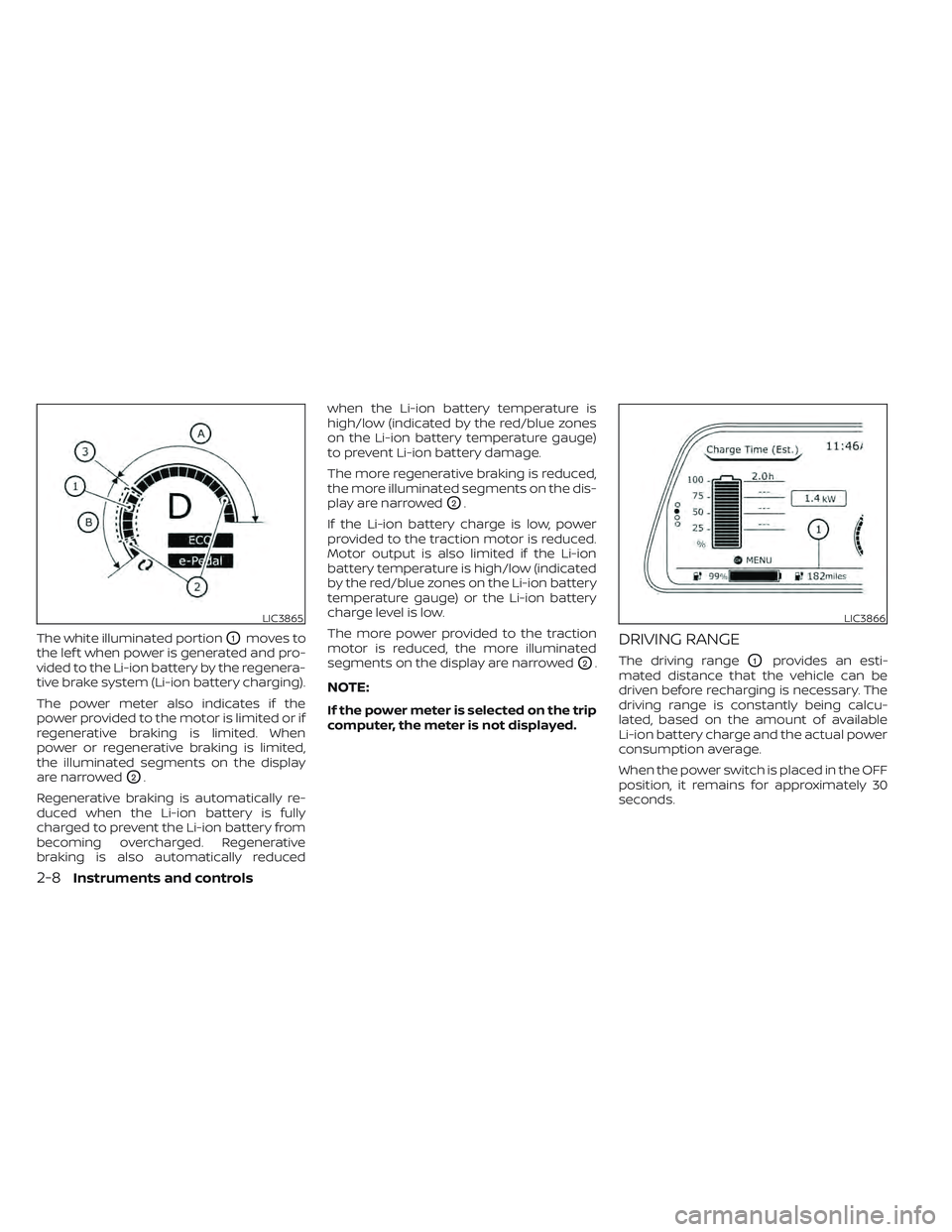
The white illuminated portionO1moves to
the lef t when power is generated and pro-
vided to the Li-ion battery by the regenera-
tive brake system (Li-ion battery charging).
The power meter also indicates if the
power provided to the motor is limited or if
regenerative braking is limited. When
power or regenerative braking is limited,
the illuminated segments on the display
are narrowed
O2.
Regenerative braking is automatically re-
duced when the Li-ion battery is fully
charged to prevent the Li-ion battery from
becoming overcharged. Regenerative
braking is also automatically reduced when the Li-ion battery temperature is
high/low (indicated by the red/blue zones
on the Li-ion battery temperature gauge)
to prevent Li-ion battery damage.
The more regenerative braking is reduced,
the more illuminated segments on the dis-
play are narrowed
O2.
If the Li-ion battery charge is low, power
provided to the traction motor is reduced.
Motor output is also limited if the Li-ion
battery temperature is high/low (indicated
by the red/blue zones on the Li-ion battery
temperature gauge) or the Li-ion battery
charge level is low.
The more power provided to the traction
motor is reduced, the more illuminated
segments on the display are narrowed
O2.
NOTE:
If the power meter is selected on the trip
computer, the meter is not displayed.
DRIVING RANGE
The driving rangeO1provides an esti-
mated distance that the vehicle can be
driven before recharging is necessary. The
driving range is constantly being calcu-
lated, based on the amount of available
Li-ion battery charge and the actual power
consumption average.
When the power switch is placed in the OFF
position, it remains for approximately 30
seconds.
LIC3865LIC3866
2-8Instruments and controls
Page 197 of 618
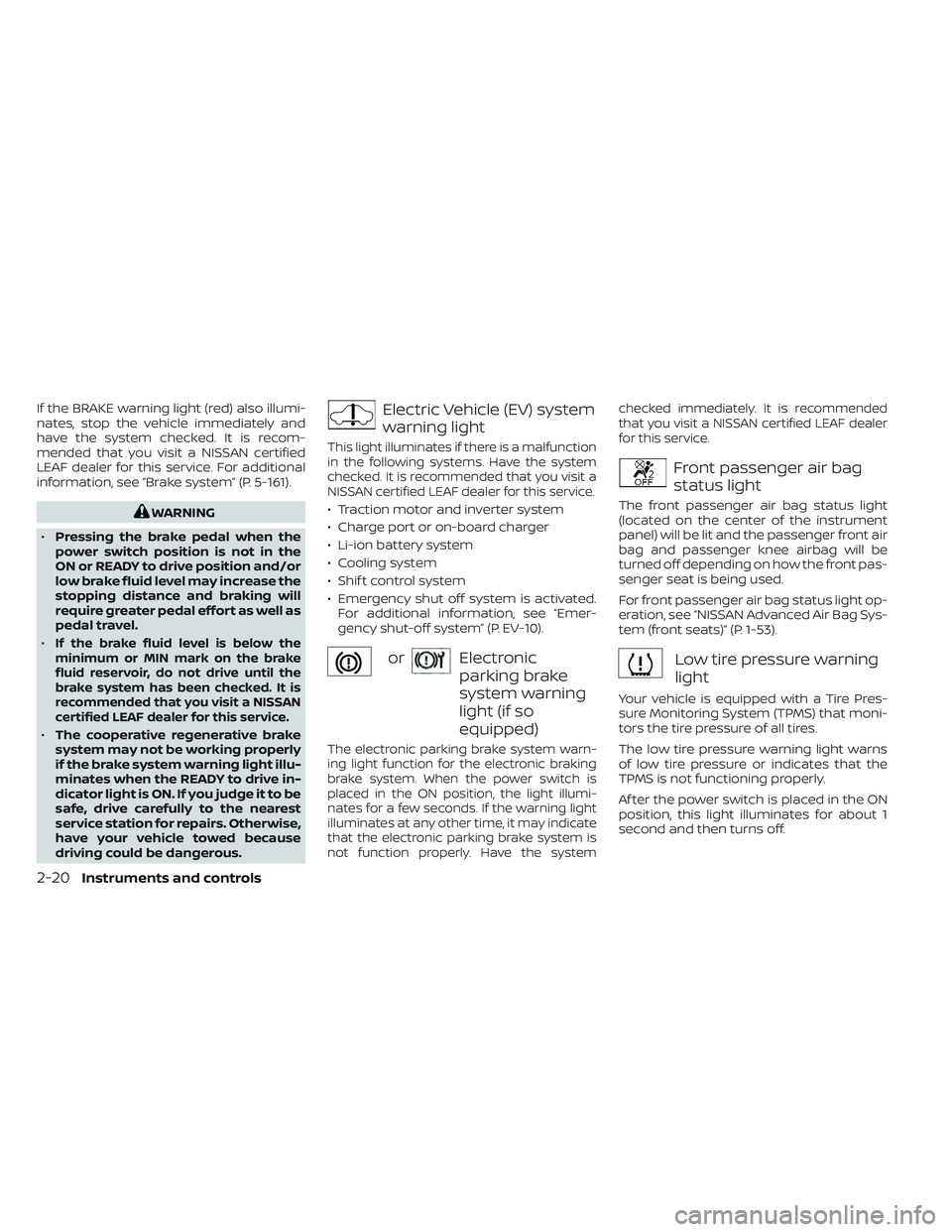
If the BRAKE warning light (red) also illumi-
nates, stop the vehicle immediately and
have the system checked. It is recom-
mended that you visit a NISSAN certified
LEAF dealer for this service. For additional
information, see “Brake system” (P. 5-161).
WARNING
• Pressing the brake pedal when the
power switch position is not in the
ON or READY to drive position and/or
low brake fluid level may increase the
stopping distance and braking will
require greater pedal effort as well as
pedal travel.
•
If the brake fluid level is below the
minimum or MIN mark on the brake
fluid reservoir, do not drive until the
brake system has been checked. It is
recommended that you visit a NISSAN
certified LEAF dealer for this service.
• The cooperative regenerative brake
system may not be working properly
if the brake system warning light illu-
minates when the READY to drive in-
dicator light is ON. If you judge it to be
safe, drive carefully to the nearest
service station for repairs. Otherwise,
have your vehicle towed because
driving could be dangerous.
Electric Vehicle (EV) system
warning light
This light illuminates if there is a malfunction
in the following systems. Have the system
checked. It is recommended that you visit a
NISSAN certified LEAF dealer for this service.
• Traction motor and inverter system
• Charge port or on-board charger
• Li-ion battery system
• Cooling system
• Shif t control system
• Emergency shut off system is activated. For additional information, see “Emer-
gency shut-off system” (P. EV-10).
orElectronic
parking brake
system warning
light (if so
equipped)
The electronic parking brake system warn-
ing light function for the electronic braking
brake system. When the power switch is
placed in the ON position, the light illumi-
nates for a few seconds. If the warning light
illuminates at any other time, it may indicate
that the electronic parking brake system is
not function properly. Have the system checked immediately. It is recommended
that you visit a NISSAN certified LEAF dealer
for this service.
Front passenger air bag
status light
The front passenger air bag status light
(located on the center of the instrument
panel) will be lit and the passenger front air
bag and passenger knee airbag will be
turned off depending on how the front pas-
senger seat is being used.
For front passenger air bag status light op-
eration, see “NISSAN Advanced Air Bag Sys-
tem (front seats)” (P. 1-53).
Low tire pressure warning
light
Your vehicle is equipped with a Tire Pres-
sure Monitoring System (TPMS) that moni-
tors the tire pressure of all tires.
The low tire pressure warning light warns
of low tire pressure or indicates that the
TPMS is not functioning properly.
Af ter the power switch is placed in the ON
position, this light illuminates for about 1
second and then turns off.
2-20Instruments and controls
Page 200 of 618
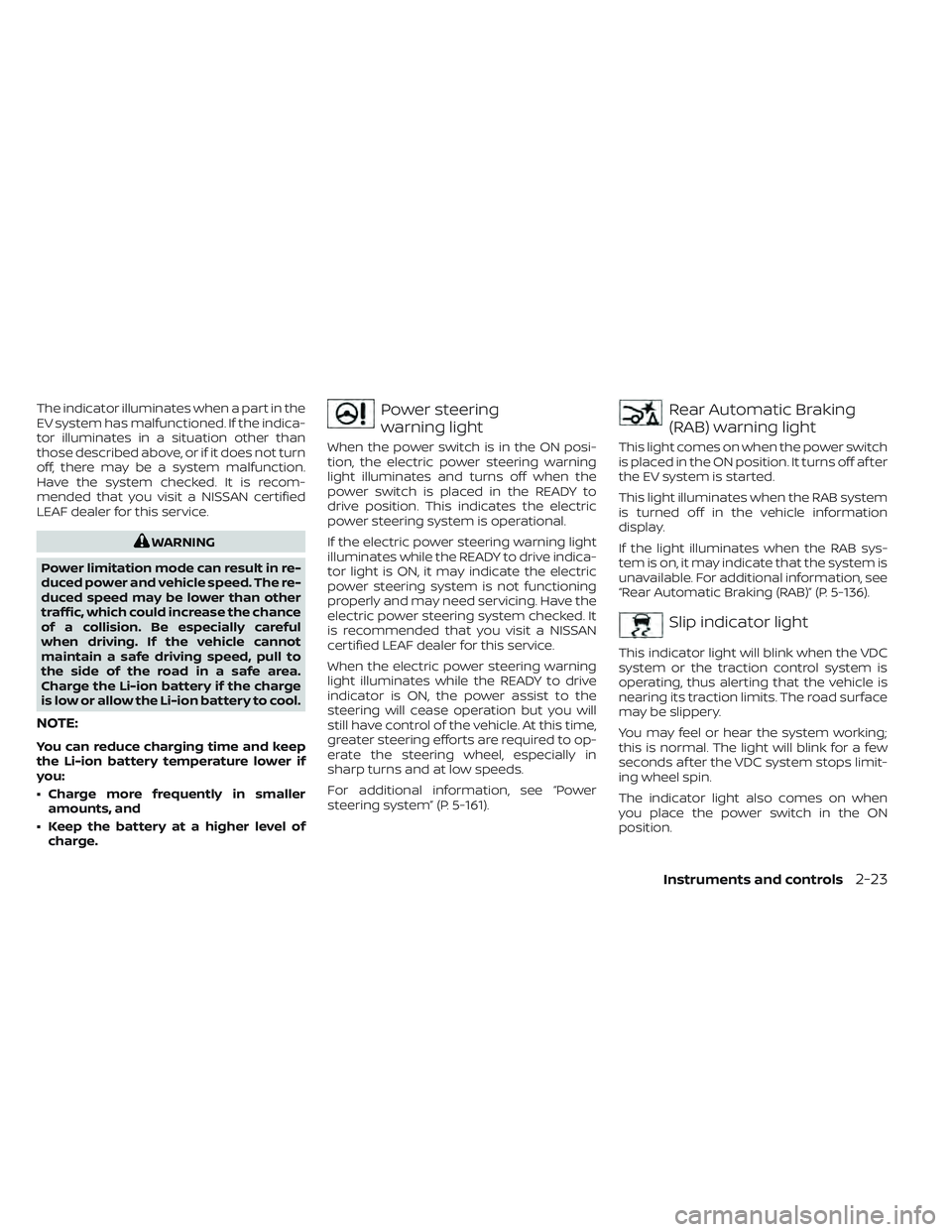
The indicator illuminates when a part in the
EV system has malfunctioned. If the indica-
tor illuminates in a situation other than
those described above, or if it does not turn
off, there may be a system malfunction.
Have the system checked. It is recom-
mended that you visit a NISSAN certified
LEAF dealer for this service.
WARNING
Power limitation mode can result in re-
duced power and vehicle speed. The re-
duced speed may be lower than other
traffic, which could increase the chance
of a collision. Be especially careful
when driving. If the vehicle cannot
maintain a safe driving speed, pull to
the side of the road in a safe area.
Charge the Li-ion battery if the charge
is low or allow the Li-ion battery to cool.
NOTE:
You can reduce charging time and keep
the Li-ion battery temperature lower if
you:
• Charge more frequently in smaller amounts, and
• Keep the battery at a higher level of charge.
Power steering
warning light
When the power switch is in the ON posi-
tion, the electric power steering warning
light illuminates and turns off when the
power switch is placed in the READY to
drive position. This indicates the electric
power steering system is operational.
If the electric power steering warning light
illuminates while the READY to drive indica-
tor light is ON, it may indicate the electric
power steering system is not functioning
properly and may need servicing. Have the
electric power steering system checked. It
is recommended that you visit a NISSAN
certified LEAF dealer for this service.
When the electric power steering warning
light illuminates while the READY to drive
indicator is ON, the power assist to the
steering will cease operation but you will
still have control of the vehicle. At this time,
greater steering efforts are required to op-
erate the steering wheel, especially in
sharp turns and at low speeds.
For additional information, see “Power
steering system” (P. 5-161).
Rear Automatic Braking
(RAB) warning light
This light comes on when the power switch
is placed in the ON position. It turns off af ter
the EV system is started.
This light illuminates when the RAB system
is turned off in the vehicle information
display.
If the light illuminates when the RAB sys-
tem is on, it may indicate that the system is
unavailable. For additional information, see
“Rear Automatic Braking (RAB)” (P. 5-136).
Slip indicator light
This indicator light will blink when the VDC
system or the traction control system is
operating, thus alerting that the vehicle is
nearing its traction limits. The road surface
may be slippery.
You may feel or hear the system working;
this is normal. The light will blink for a few
seconds af ter the VDC system stops limit-
ing wheel spin.
The indicator light also comes on when
you place the power switch in the ON
position.
Instruments and controls2-23
Page 342 of 618
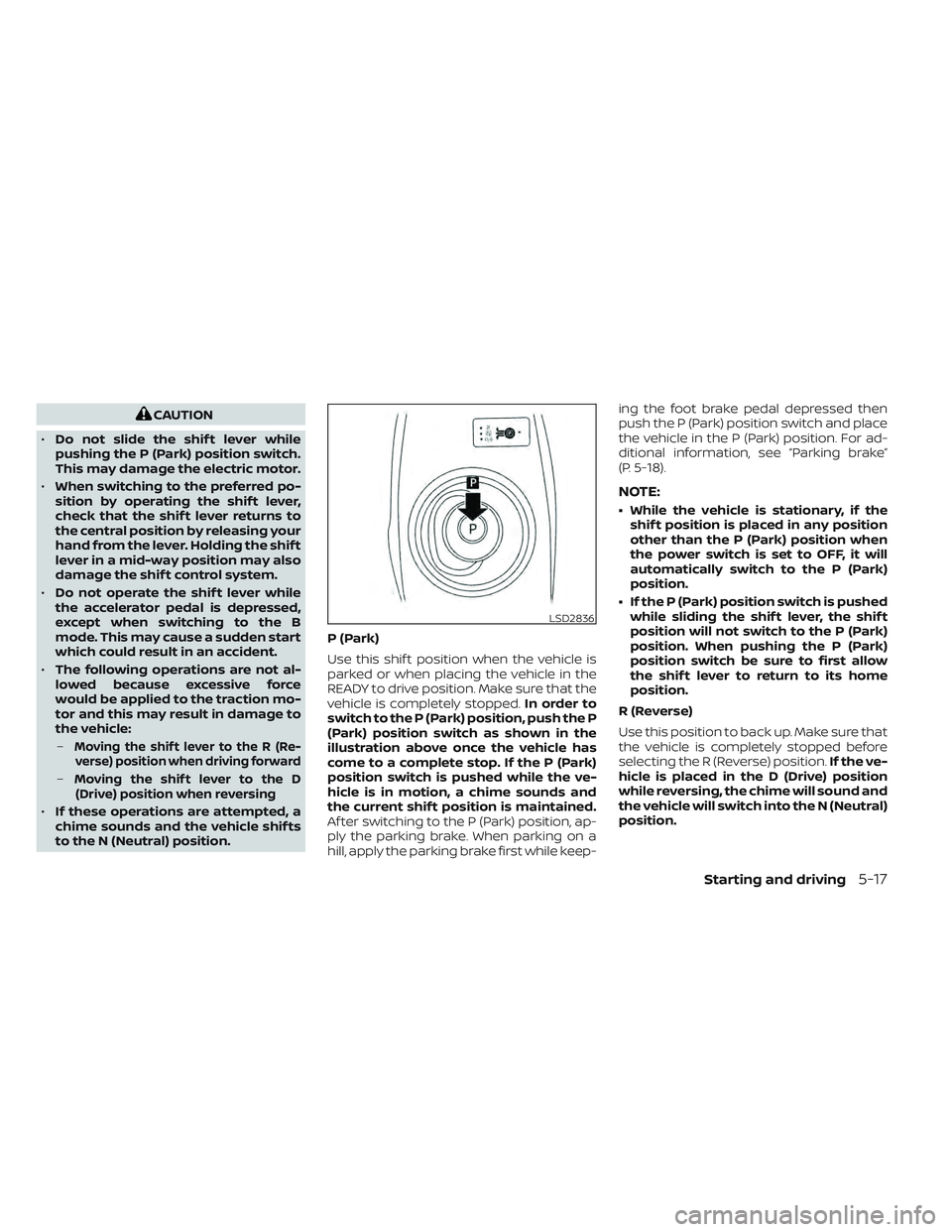
CAUTION
• Do not slide the shif t lever while
pushing the P (Park) position switch.
This may damage the electric motor.
• When switching to the preferred po-
sition by operating the shif t lever,
check that the shif t lever returns to
the central position by releasing your
hand from the lever. Holding the shif t
lever in a mid-way position may also
damage the shif t control system.
• Do not operate the shif t lever while
the accelerator pedal is depressed,
except when switching to the B
mode. This may cause a sudden start
which could result in an accident.
• The following operations are not al-
lowed because excessive force
would be applied to the traction mo-
tor and this may result in damage to
the vehicle:
–
Moving the shif t lever to the R (Re-verse) position when driving forward
–Moving the shif t lever to the D(Drive) position when reversing
• If these operations are attempted, a
chime sounds and the vehicle shif ts
to the N (Neutral) position. P (Park)
Use this shif t position when the vehicle is
parked or when placing the vehicle in the
READY to drive position. Make sure that the
vehicle is completely stopped.
In order to
switch to the P (Park) position, push the P
(Park) position switch as shown in the
illustration above once the vehicle has
come to a complete stop. If the P (Park)
position switch is pushed while the ve-
hicle is in motion, a chime sounds and
the current shif t position is maintained.
Af ter switching to the P (Park) position, ap-
ply the parking brake. When parking on a
hill, apply the parking brake first while keep- ing the foot brake pedal depressed then
push the P (Park) position switch and place
the vehicle in the P (Park) position. For ad-
ditional information, see “Parking brake”
(P. 5-18).
NOTE:
• While the vehicle is stationary, if the
shif t position is placed in any position
other than the P (Park) position when
the power switch is set to OFF, it will
automatically switch to the P (Park)
position.
• If the P (Park) position switch is pushed while sliding the shif t lever, the shif t
position will not switch to the P (Park)
position. When pushing the P (Park)
position switch be sure to first allow
the shif t lever to return to its home
position.
R (Reverse)
Use this position to back up. Make sure that
the vehicle is completely stopped before
selecting the R (Reverse) position. If the ve-
hicle is placed in the D (Drive) position
while reversing, the chime will sound and
the vehicle will switch into the N (Neutral)
position.
LSD2836
Starting and driving5-17
Page 359 of 618
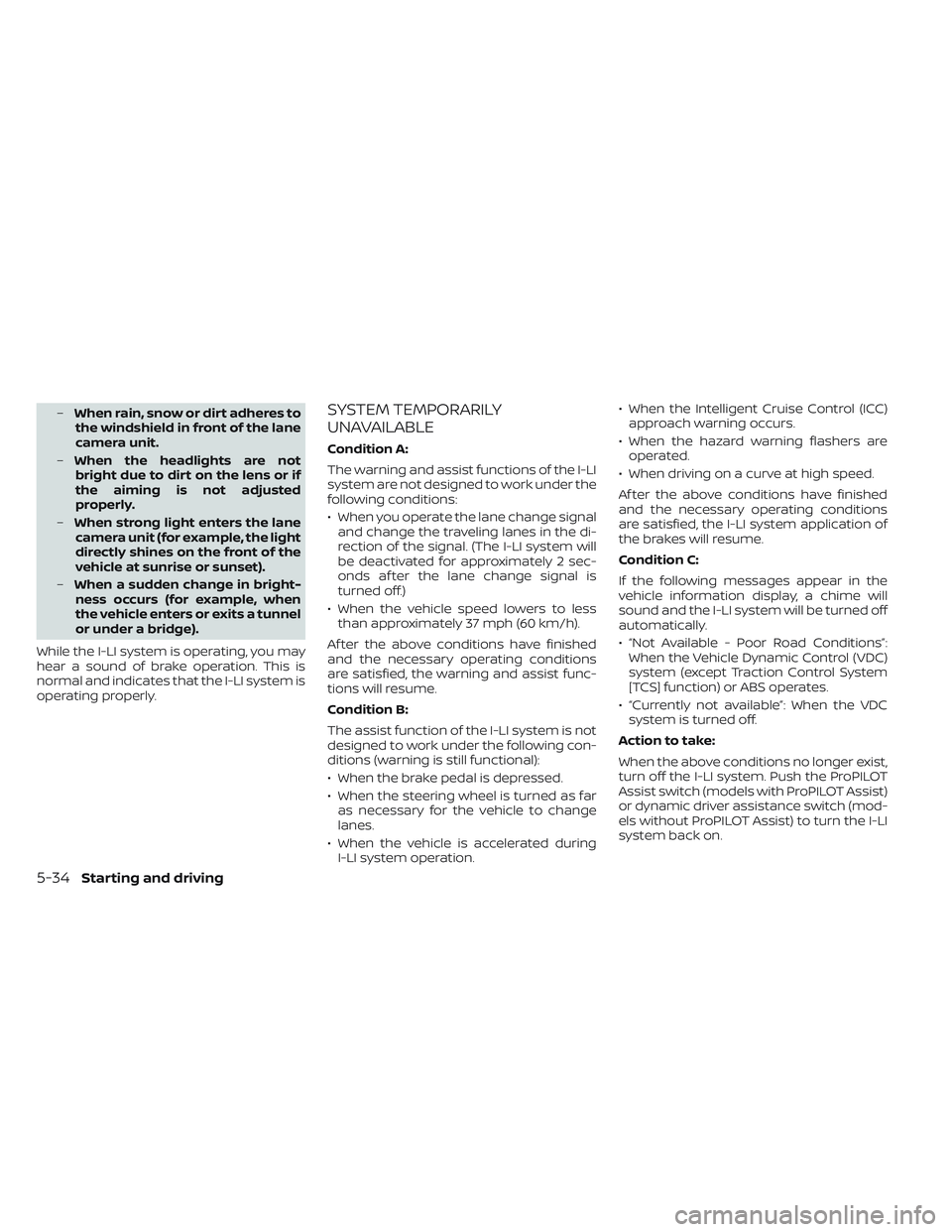
–When rain, snow or dirt adheres to
the windshield in front of the lane
camera unit.
– When the headlights are not
bright due to dirt on the lens or if
the aiming is not adjusted
properly.
– When strong light enters the lane
camera unit (for example, the light
directly shines on the front of the
vehicle at sunrise or sunset).
– When a sudden change in bright-
ness occurs (for example, when
the vehicle enters or exits a tunnel
or under a bridge).
While the I-LI system is operating, you may
hear a sound of brake operation. This is
normal and indicates that the I-LI system is
operating properly.SYSTEM TEMPORARILY
UNAVAILABLE
Condition A:
The warning and assist functions of the I-LI
system are not designed to work under the
following conditions:
• When you operate the lane change signal and change the traveling lanes in the di-
rection of the signal. (The I-LI system will
be deactivated for approximately 2 sec-
onds af ter the lane change signal is
turned off.)
• When the vehicle speed lowers to less than approximately 37 mph (60 km/h).
Af ter the above conditions have finished
and the necessary operating conditions
are satisfied, the warning and assist func-
tions will resume.
Condition B:
The assist function of the I-LI system is not
designed to work under the following con-
ditions (warning is still functional):
• When the brake pedal is depressed.
• When the steering wheel is turned as far as necessary for the vehicle to change
lanes.
• When the vehicle is accelerated during I-LI system operation. • When the Intelligent Cruise Control (ICC)
approach warning occurs.
• When the hazard warning flashers are operated.
• When driving on a curve at high speed.
Af ter the above conditions have finished
and the necessary operating conditions
are satisfied, the I-LI system application of
the brakes will resume.
Condition C:
If the following messages appear in the
vehicle information display, a chime will
sound and the I-LI system will be turned off
automatically.
• “Not Available - Poor Road Conditions”: When the Vehicle Dynamic Control (VDC)
system (except Traction Control System
[TCS] function) or ABS operates.
• “Currently not available”: When the VDC system is turned off.
Action to take:
When the above conditions no longer exist,
turn off the I-LI system. Push the ProPILOT
Assist switch (models with ProPILOT Assist)
or dynamic driver assistance switch (mod-
els without ProPILOT Assist) to turn the I-LI
system back on.
5-34Starting and driving
Page 416 of 618
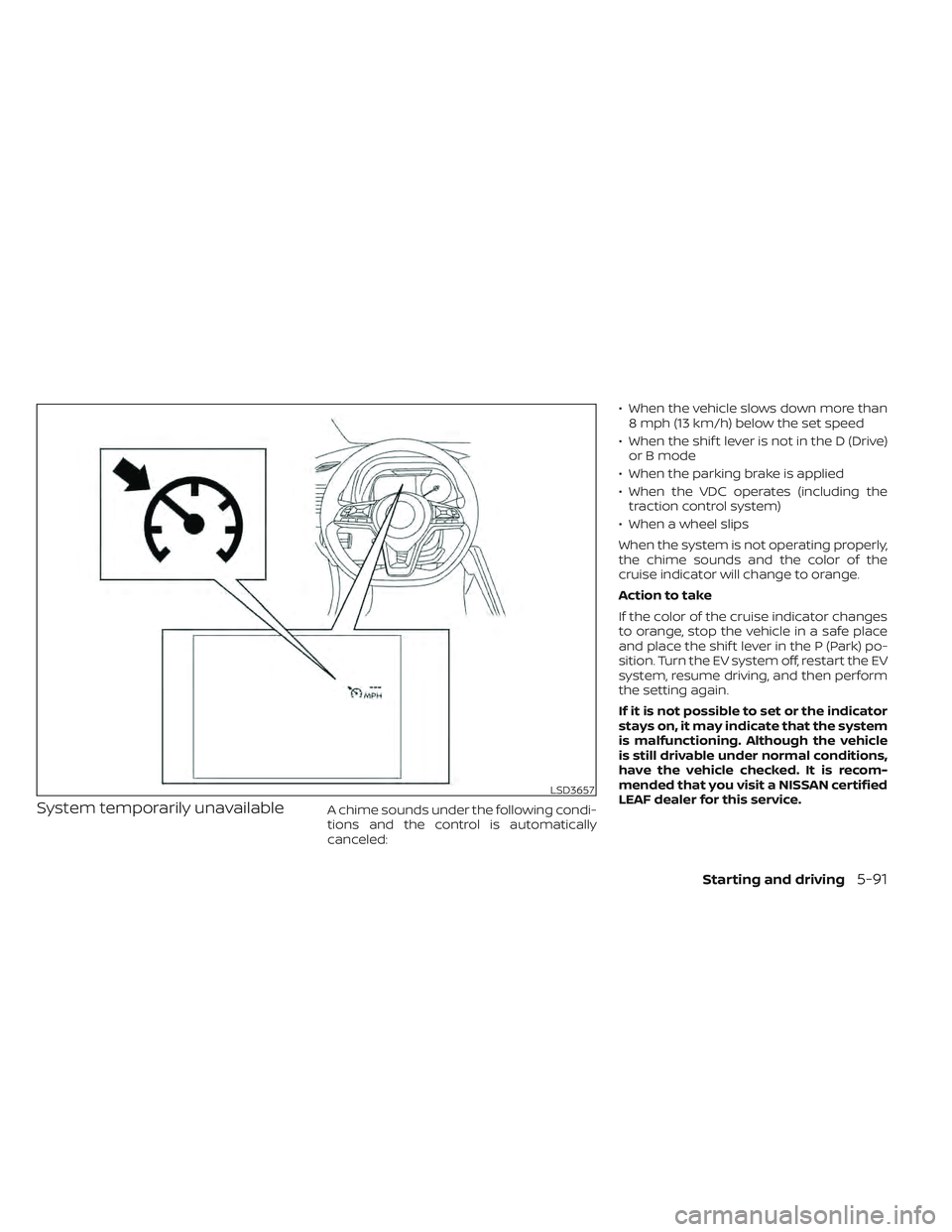
System temporarily unavailableA chime sounds under the following condi-
tions and the control is automatically
canceled:• When the vehicle slows down more than
8 mph (13 km/h) below the set speed
• When the shif t lever is not in the D (Drive) or B mode
• When the parking brake is applied
• When the VDC operates (including the traction control system)
• When a wheel slips
When the system is not operating properly,
the chime sounds and the color of the
cruise indicator will change to orange.
Action to take
If the color of the cruise indicator changes
to orange, stop the vehicle in a safe place
and place the shif t lever in the P (Park) po-
sition. Turn the EV system off, restart the EV
system, resume driving, and then perform
the setting again.
If it is not possible to set or the indicator
stays on, it may indicate that the system
is malfunctioning. Although the vehicle
is still drivable under normal conditions,
have the vehicle checked. It is recom-
mended that you visit a NISSAN certified
LEAF dealer for this service.
LSD3657
Starting and driving5-91
Page 436 of 618
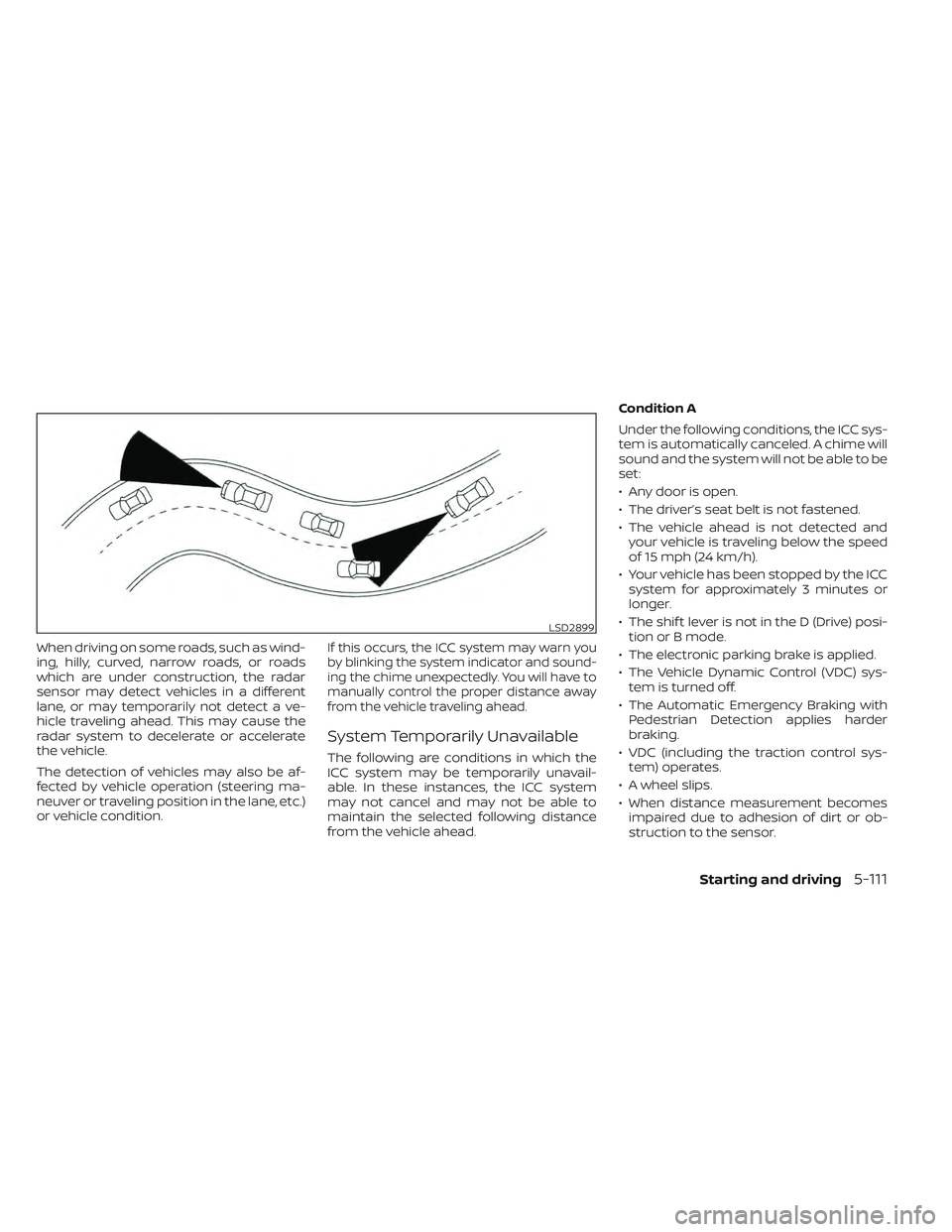
When driving on some roads, such as wind-
ing, hilly, curved, narrow roads, or roads
which are under construction, the radar
sensor may detect vehicles in a different
lane, or may temporarily not detect a ve-
hicle traveling ahead. This may cause the
radar system to decelerate or accelerate
the vehicle.
The detection of vehicles may also be af-
fected by vehicle operation (steering ma-
neuver or traveling position in the lane, etc.)
or vehicle condition.If this occurs, the ICC system may warn you
by blinking the system indicator and sound-
ing the chime unexpectedly. You will have to
manually control the proper distance away
from the vehicle traveling ahead.
System Temporarily Unavailable
The following are conditions in which the
ICC system may be temporarily unavail-
able. In these instances, the ICC system
may not cancel and may not be able to
maintain the selected following distance
from the vehicle ahead.Condition A
Under the following conditions, the ICC sys-
tem is automatically canceled. A chime will
sound and the system will not be able to be
set:
• Any door is open.
• The driver’s seat belt is not fastened.
• The vehicle ahead is not detected and
your vehicle is traveling below the speed
of 15 mph (24 km/h).
• Your vehicle has been stopped by the ICC system for approximately 3 minutes or
longer.
• The shif t lever is not in the D (Drive) posi- tion or B mode.
• The electronic parking brake is applied.
• The Vehicle Dynamic Control (VDC) sys- tem is turned off.
• The Automatic Emergency Braking with Pedestrian Detection applies harder
braking.
• VDC (including the traction control sys- tem) operates.
• A wheel slips.
• When distance measurement becomes impaired due to adhesion of dirt or ob-
struction to the sensor.
LSD2899
Starting and driving5-111
Page 479 of 618
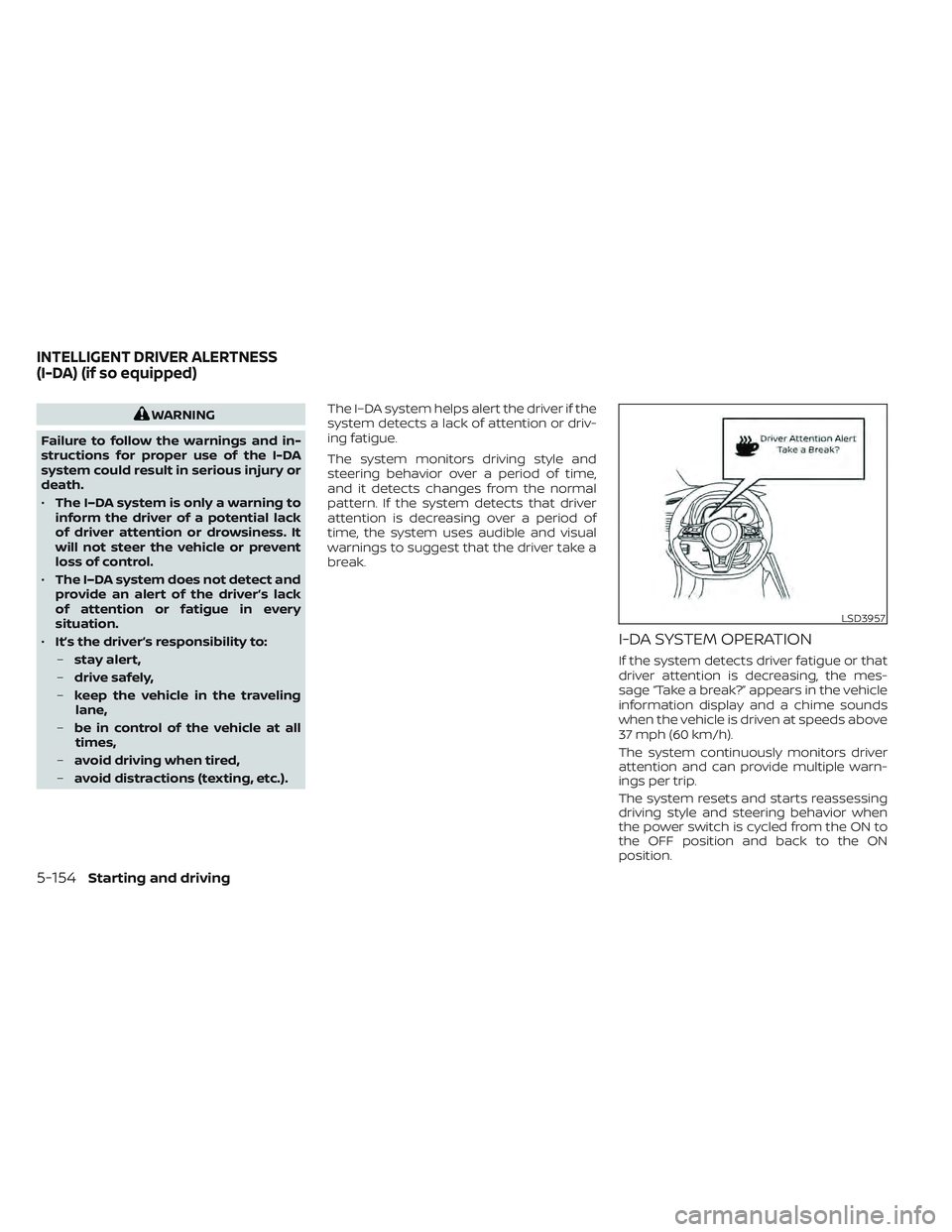
WARNING
Failure to follow the warnings and in-
structions for proper use of the I-DA
system could result in serious injury or
death.
• The I–DA system is only a warning to
inform the driver of a potential lack
of driver attention or drowsiness. It
will not steer the vehicle or prevent
loss of control.
• The I–DA system does not detect and
provide an alert of the driver’s lack
of attention or fatigue in every
situation.
• It’s the driver’s responsibility to:
– stay alert,
– drive safely,
– keep the vehicle in the traveling
lane,
– be in control of the vehicle at all
times,
– avoid driving when tired,
– avoid distractions (texting, etc.). The I–DA system helps alert the driver if the
system detects a lack of attention or driv-
ing fatigue.
The system monitors driving style and
steering behavior over a period of time,
and it detects changes from the normal
pattern. If the system detects that driver
attention is decreasing over a period of
time, the system uses audible and visual
warnings to suggest that the driver take a
break.
I-DA SYSTEM OPERATION
If the system detects driver fatigue or that
driver attention is decreasing, the mes-
sage “Take a break?” appears in the vehicle
information display and a chime sounds
when the vehicle is driven at speeds above
37 mph (60 km/h).
The system continuously monitors driver
attention and can provide multiple warn-
ings per trip.
The system resets and starts reassessing
driving style and steering behavior when
the power switch is cycled from the ON to
the OFF position and back to the ON
position.
LSD3957
INTELLIGENT DRIVER ALERTNESS
(I-DA) (if so equipped)
5-154Starting and driving